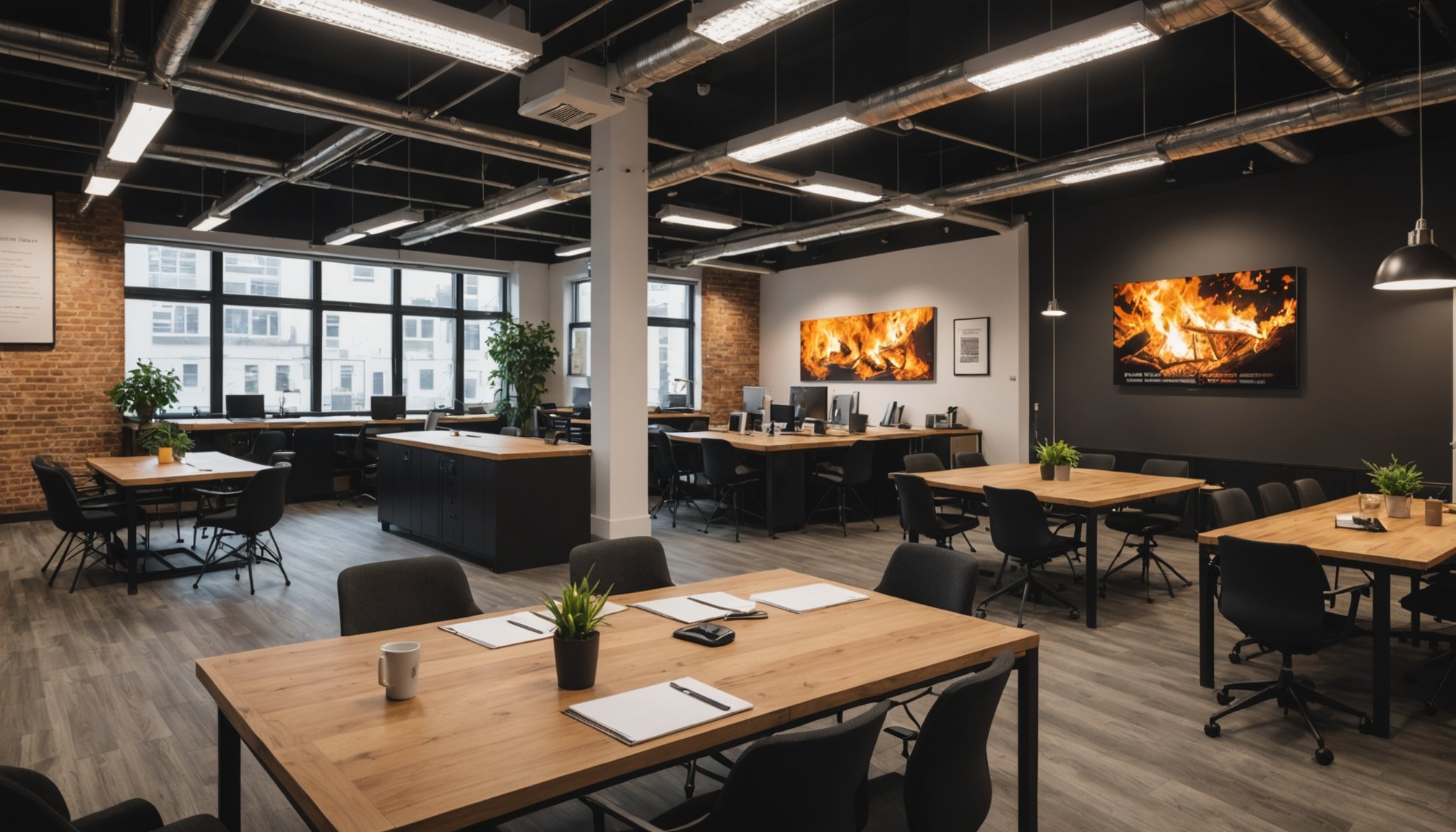Creating a Fire-Safe UK Coworking Space: A Step-by-Step Compliance Guide
Understanding the Importance of Fire Safety
When it comes to coworking spaces, the safety of the people using these facilities is paramount. Fire safety, in particular, is a critical aspect that cannot be overlooked. A fire can break out unexpectedly, causing significant damage and posing a severe risk to life. Therefore, it is essential to ensure that your UK coworking space is fully compliant with all relevant fire safety regulations.
Conducting a Risk Assessment
The first and most crucial step in creating a fire-safe coworking space is to conduct a thorough risk assessment. This process involves identifying potential fire hazards, evaluating the risks associated with these hazards, and implementing measures to mitigate or eliminate them.
Additional reading : Your ultimate blueprint for starting a uk artisan craft marketplace: essential steps for seller compliance and success
Key Elements of a Risk Assessment
- Identify Hazards: Look for sources of ignition, fuel, and oxygen. Common hazards include electrical equipment, kitchen appliances, and flammable materials.
- Evaluate Risks: Assess the likelihood and potential impact of a fire occurring.
- Implement Controls: Install fire alarms, ensure proper ventilation, and keep flammable materials away from heat sources.
- Monitor and Review: Regularly review and update the risk assessment to ensure it remains relevant and effective.
Appointing a Responsible Person
Under UK law, every workplace must have a ‘responsible person’ who is in charge of ensuring fire safety. This person is typically the building owner, manager, or someone with significant control over the premises.
Responsibilities of the Responsible Person
- Conduct Risk Assessments: Ensure regular risk assessments are carried out.
- Implement Fire Safety Measures: Install and maintain fire alarms, fire extinguishers, and other safety systems.
- Provide Training: Ensure all staff and users of the coworking space are trained in fire safety procedures.
- Maintain Records: Keep records of risk assessments, training, and maintenance of fire safety systems.
Building Systems and Fire Safety
The building itself plays a critical role in fire safety. Here are some key elements to focus on:
This might interest you : Navigating uk competition and markets authority regulations: an essential guide for launching your e-commerce platform
Fire Alarms and Detection Systems
- Installation: Ensure that fire alarms are installed in accordance with British Standards (BS 5839-1).
- Maintenance: Regularly test and maintain fire alarms to ensure they are functioning correctly.
- User Training: Train users on how to respond to fire alarms and what actions to take.
Fire Extinguishers
- Placement: Position fire extinguishers in easily accessible locations, typically on each floor and near exits.
- Types: Ensure the correct types of fire extinguishers are provided for the types of fires that could occur (e.g., electrical, paper, or chemical fires).
- Inspection: Regularly inspect fire extinguishers to ensure they are fully charged and ready for use.
Escape Routes and Emergency Lighting
- Clear Routes: Ensure all escape routes are clear of obstacles and easily accessible.
- Emergency Lighting: Install emergency lighting to illuminate escape routes in the event of a power failure.
- Signage: Clearly sign escape routes and emergency exits.
Ensuring Compliance with Regulatory Requirements
Compliance with fire safety regulations is not just a moral obligation but a legal requirement. Here are some key regulatory aspects to consider:
The Regulatory Reform (Fire Safety) Order 2005
- This order requires the responsible person to ensure that a fire risk assessment is carried out and that appropriate measures are taken to mitigate any identified risks.
- It also mandates the provision of fire safety information to employees and other relevant persons.
British Standards
- BS 9999:2017: This standard provides guidance on fire safety in the design, management, and use of buildings.
- BS 5839-1:2017: This standard covers the planning, design, installation, commissioning, and maintenance of fire alarm systems.
Practical Guidance for Coworking Spaces
Here are some practical tips to ensure your coworking space is fire-safe:
Regular Maintenance
- Regularly inspect and maintain all fire safety systems, including fire alarms and extinguishers.
- Ensure that all electrical equipment is properly installed and maintained.
User Education
- Provide regular fire safety training to all users of the coworking space.
- Ensure that everyone knows the escape routes and what to do in the event of a fire.
Fire Drills
- Conduct regular fire drills to ensure that everyone is prepared in the event of a fire.
- Use these drills to identify any weaknesses in your fire safety procedures.
Example of a Fire Safety Plan
Here is an example of what a fire safety plan for a coworking space might look like:
| Element | Description | Responsibility | Frequency |
|---|---|---|---|
| Risk Assessment | Identify and evaluate fire hazards | Responsible Person | Annually |
| Fire Alarm Testing | Test fire alarms to ensure functionality | Facilities Manager | Weekly |
| Fire Extinguisher Inspection | Inspect fire extinguishers for charge and accessibility | Facilities Manager | Monthly |
| Escape Route Clearance | Ensure escape routes are clear of obstacles | Facilities Manager | Daily |
| User Training | Provide fire safety training to users | Responsible Person | Quarterly |
| Fire Drills | Conduct fire drills to test emergency procedures | Responsible Person | Bi-Annually |
Quotes and Insights from Experts
“Fire safety is not just about compliance; it’s about ensuring the safety and well-being of everyone in the building. A thorough risk assessment and regular maintenance of fire safety systems are crucial,” says Jane Smith, a fire safety consultant.
“User education is key. People need to know what to do in the event of a fire. Regular training and fire drills can make all the difference,” adds John Doe, a fire safety trainer.
Creating a fire-safe UK coworking space requires a comprehensive approach that includes conducting risk assessments, appointing a responsible person, ensuring compliance with regulatory requirements, and providing regular maintenance and user education. By following these steps and staying informed about the latest standards and best practices, you can ensure a safe and secure environment for everyone using your coworking space.
Detailed Checklist for Fire Safety Compliance
Here is a detailed checklist to help you ensure your coworking space is compliant with fire safety regulations:
General Fire Safety
- Fire Risk Assessment: Conduct a thorough risk assessment to identify potential fire hazards.
- Fire Safety Policy: Develop and implement a fire safety policy.
- Responsible Person: Appoint a responsible person to oversee fire safety.
Fire Alarms and Detection Systems
- Installation: Install fire alarms in accordance with British Standards.
- Testing: Regularly test fire alarms to ensure functionality.
- Maintenance: Maintain fire alarms and detection systems.
Fire Extinguishers
- Placement: Position fire extinguishers in easily accessible locations.
- Types: Ensure the correct types of fire extinguishers are provided.
- Inspection: Regularly inspect fire extinguishers.
Escape Routes and Emergency Lighting
- Clear Routes: Ensure all escape routes are clear of obstacles.
- Emergency Lighting: Install emergency lighting to illuminate escape routes.
- Signage: Clearly sign escape routes and emergency exits.
User Education and Training
- Fire Safety Training: Provide regular fire safety training to users.
- Fire Drills: Conduct regular fire drills to test emergency procedures.
Maintenance and Inspection
- Regular Maintenance: Regularly inspect and maintain all fire safety systems.
- Electrical Equipment: Ensure all electrical equipment is properly installed and maintained.
By following this comprehensive guide, you can ensure that your UK coworking space is not only compliant with fire safety regulations but also a safe and secure environment for everyone.











